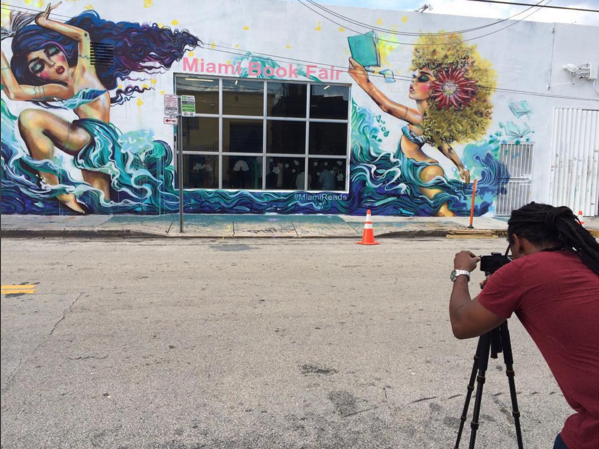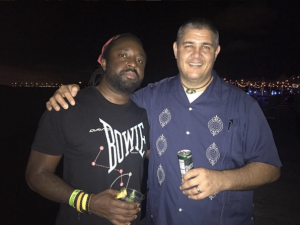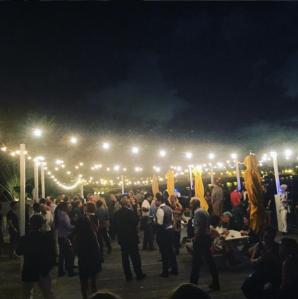
A glamorous poolside gathering at a trendy hotel is typical in Miami. Less typical is chatting up this year’s Man Booker Prize winner, but that is how I spent my Friday night.
The occasion was an author party for the Miami Book Fair International, a weeklong festival hosted by Miami Dade College (MDC) and Books & Books, two anchor cultural institutions in the Magic City. The event, covered by PBS and C-SPAN, is the largest community book festival in the U.S.
“This is the 10th anniversary of my first book, and also of my first [Miami] book fair,” Marlon James told me. Since that first appearance, he had been back seven times. In October, Mr. James was awarded the Man Booker Prize for his novel A Brief History of Seven Killings.
Over the course of the fair’s eight days, some 250,000 patrons flock to the streets of downtown Miami to hear over 700 authors, including Mitch Albom, Joyce Carol Oates and Amy Tan, as well as cultural icons like Patti Smith, Paul Giamatti, Jesse Eisenberg, Ted Koppel, Tom Brokaw and Rosie Perez, discuss their latest works.
And, of course, to see the books.

Mr. James loved the Miami Book Fair because of its “unique” atmosphere. “Not unique physically,” he clarified, gesturing to the twinkly lights reflecting off of Biscayne Bay and the scantily dressed crowd enjoying outdoor cocktails in November, “but because of Mitch.”
“Mitch has a knack for choosing up-and coming authors who haven’t made it big yet, but who end up being the ‘next big thing,’” Mr. James says, describing a spidey-sense like ability.
A WORLD OF HIS OWN
The Mitch he refers to is Mitchell Kaplan, owner of Books & Books. The Miami Book Fair International is his brainchild, conceived jointly with Dr. Eduardo Padron, MDC’s president.
I asked Mr. Kaplan to describe his instincts about authors. “It’s hard to say,” he started. “I’m not interested in building a canon. I pay attention to the writer’s voice and try to sift through the poseurs.”
The seeds for the fair were sown while Mr. Kaplan was an undergraduate at the University of Colorado, Boulder. He realized an entire world existed beyond the “plastic” of his native Miami Beach, one populated with books. “I was drawn to the dynamism of expression. I wanted to create my own world,” he told me, “if that makes sense.”
It made sense. Before three years ago, I never imagined myself visiting Miami, much less living here, and yet here was where I found myself. I couldn’t quite make sense of this city—a gross understatement of what I was actually going through—but not two months after arriving, I went to my first Miami Book Fair. It was a turning point.
When I am asked how long I’ve lived in Miami, I don’t answer in terms of years, but in terms of book fairs.
It’s like when Sandra Cisneros met her hero, tango composer and bandoneon player Astor Piazzola, at a concert, following a difficult time in her life. At an author panel on Saturday, Ms. Cisneros shared this experience, recounted in her memoir, A House of My Own: Stories from My Life. Nervous to address the musician, she imagines what she would have liked to say:
“Astor, your music has buoyed me through so many disappointments, through the exploding cigars of love, through near deaths, through my own death and resurrection. I traveled to find myself when I listened to your music… Astor, you taught me with your music the kind of passion I wanted to reach in my work… When I was cold and afraid, to be fearless…
“Astor, everything was in your music, the nemesis I loved who abandoned me, and how from that open would, I had transformed the yelp into a howl, and that howl was my work, inspired by you, Astor.”
The audience laughed when Ms. Cisneros said she believed the greatest composer and musician of the new tango had come to town just to play for her. I understood she was not being hyperbolic.
“The Miami Book Fair was the argument for you to live in Miami?” an incredulous Paul Holdengraber, director of LIVE from the NYPL, asked me, parroting what I’d just told him. I confirmed so, and then explained that when I am asked how long I’ve lived in Miami, I don’t answer in terms of years, but in terms of book fairs. As in, “I’ve been here three book fairs.”
BEYOND DIAPER CITY

On Saturday night, reviewing notes dictated on my phone, I discovered an unfortunate error. It seemed the phone had transcribed “diaper city” in a number of places.
I meant diversity.
Later I realized this was a rather common misreading. Miami is often considered a “diaper city” and continues to butt many jokes despite its growing significance as a market that counts internationalism and diversity among its strongest assets. For instance, the fact that its airport is the second-largest in the U.S. for international passengers and number one for international air freight does not figure into these write-offs.
While for other aspects of its economy, a Miami apologist might say, “Oh, but Miami is a young city, an infant compared to established places like New York,” in the case of the book fair, this would not apply. Miami Book Fair International is 32 this year—old enough to vote, drink, rent a car, and serve as a model for other cities.
For his pioneering efforts, Mr. Kaplan was awarded the National Book Award’s Lifetime Achievement Award in 2011. Following this honor, the recipients of which include Lawrence Ferlinghetti, Maya Angelou and Dave Eggers, Mr. Kaplan arranged to bring the finalists of the National Book Awards (NBA), which takes place the same week as the Miami Book Fair, down to the Sunshine State.
This was the second year the prestigious awards held an event in Miami. NBA outgoing executive director Harold Augenbraum told me that rather than being a trade show, Miami’s book festival was a true “community celebration of reading,” bringing together writers and readers alike.
The ability to create these types of connections is, as Mr. Holdengraber told me, “a mitzvah.”
‘Miami is an international city with international writers. This allows for interesting polyglot conversations to take place.’
Miami’s internationalism nourishes its literary life. In 2015, VONA, a multigenre writing workshop for writers of color, moved its home base from the San Francisco Bay to the University of Miami (UM). “Miami is an international city with international writers. This allows for interesting polyglot conversations to take place,” said M. Evalina Galang, creative writing director at UM.
At the VONA panel, authors brought readers to Palestine, the Philippines, the Czech Republic, the Ural Mountains and Cuba. While broadening the horizons of the community is one benefit of institutions like VONA and the Miami Book Fair, more importantly, as Ms. Galang explained, creating a space for a multiplicity of identities allows for a more sophisticated discourse—past the point of seeking permission for certain voices to speak, and onto a deeper examination of craft.
But diversity refers to more than just the fair’s international flavor. Pulitzer Prize-winning author and this year’s NBA recipient Adam Johnson told me that what he found striking about the event was its ability to connect the highest-brow literature with the local community. He referenced the fair’s robust programming in children’s books and graphic novels, among others.
For New York Times Book Review Editor Pamela Paul, as well as author Amy Tan—a Miami Book Fair veteran who threw a rousing concert as part of the literary rock group Rock Bottom Remainders—seeing different writers interact and respond to others’ works was particularly special. “I am attracted to this fair as a reader,” she told me, rather than as an industry professional.
“This is my second visit to this book fair. After my first time, I made it my mission to be invited back.”
APERTURES OF THE HEART
No doubt the event facilitates high-level intellectual discourse, but its significance resonates beyond that. Encounters with books are transmuting experiences, not unlike love, or grief. Addressing an audience question on the latter, Ms. Cisneros says that when a person is mourning, their heart is “open, like the aperture of a camera.” Accessing that opening, she says, is what a writer strives for each time she sets out to put words on a page.
This point of aperture is also where readers are transported by books, and the communities formed around them. Or, as Mary Karr said on Saturday, “One way we meet each other is language.” About poetry, her first love, she says that it was “eucharistic.” “You take someone else’s passion or suffering and take it into the meat of your body and you’re changed by it.
“In communion, we all become a community. We are all here,” after all, “because we’re readers.”
Adeline Oka is a public speaker, essayist, ghostwriter and the editorial director of Invest: Miami. Follow her on Twitter @adeline_oka

